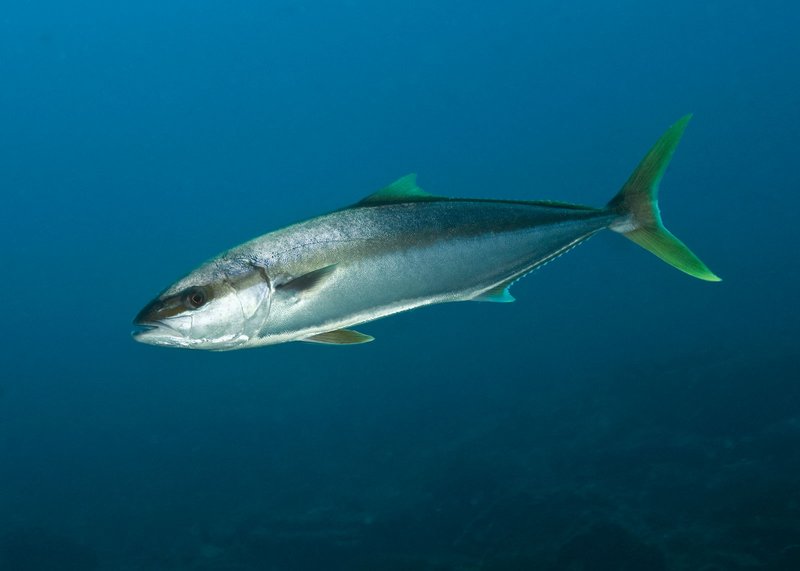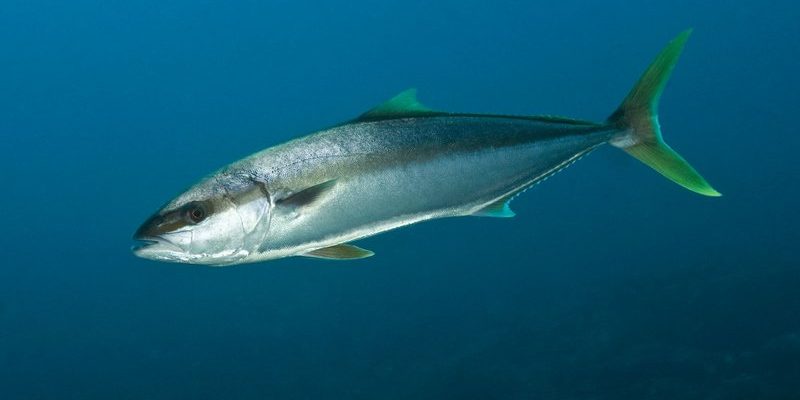
Picture yourself on a sun-soaked beach, the sea breeze gently ruffling your hair. As you dip your toes into the turquoise water, you might catch a glimpse of the vibrant Yellowtail Snapper swimming gracefully below. This fish, known for its striking yellow stripe and delicious taste, is more than just a pretty face in the ocean. Let’s dive deep into the world of the Yellowtail Snapper—its habitat, behavior, and more.
The Yellowtail Snapper (Ocyurus chrysurus) is primarily found in the warm waters of the Caribbean Sea and the Gulf of Mexico. They are popular not just among fish enthusiasts but also on dinner plates. This species can live in diverse marine environments, from coral reefs to mangroves, making them quite adaptable. If you’re curious about their diet, social behavior, and how to identify them, you’re in the right place. Grab a cup of coffee, and let’s chat about this captivating fish.
Physical Characteristics
The Yellowtail Snapper is easily recognizable thanks to its bright yellow stripe running from its head to its tail. This eye-catching feature is not just beautiful; it plays a role in communication among the fish. The body itself is typically a bluish-green color, which allows these fish to blend into their environment, providing protection from predators.
They generally reach about 20 to 30 inches in length, but larger individuals can exceed this size. Weighing up to 6-8 pounds, they have a streamlined body that allows them to dart quickly through the water. A keen observer might notice their distinctive forked tail and large eyes, which help them spot food and predators in the often dimly lit waters of their coral reef homes.
Habitat and Distribution
Yellowtail Snappers prefer shallow coastal waters and are often found around coral reefs, rocky outcrops, and mangroves. They thrive in depths ranging from 10 to 150 feet. The abundance of cover and food in these environments makes them an ideal home. You’ll often see them in small schools, darting in and out of crevices in search of food.
These fish are prevalent throughout the Caribbean, extending from Florida’s coast to the Bahamas and down to South America. Their widespread presence is a testament to their adaptability, thriving in both clear and slightly murky waters. If you ever find yourself diving or snorkeling in these areas, keep your eyes peeled; you might spot a school of Yellowtail Snapper zipping past you!
Diet and Feeding Habits
Yellowtail Snapper are opportunistic feeders, which means they eat whatever is available in their environment. Their diet mainly consists of small fish, shrimp, and various invertebrates. This fish isn’t picky, enjoying the bounty of the ocean floor. You might wonder how they catch their food. With their keen eyesight and swift movements, they can quickly ambush prey, making them efficient hunters.
They often feed during the day, taking advantage of sunlight to hunt effectively. Their feeding habits also change with their environment; in more crowded reefs, they might rely on stealth and speed, while in open waters, they may pursue prey more actively. The Yellowtail Snapper plays a significant role in controlling the populations of smaller marine creatures, contributing to the health of their ecosystem.
Reproduction and Lifespan
The spawning season for the Yellowtail Snapper usually occurs from late spring to early summer. During this time, they gather in large schools, often near the surface, to attract mates. Female Yellowtail Snappers can produce thousands of eggs in a single spawning event, releasing them into the open water. The fertilized eggs float to the surface, where they hatch into tiny larvae.
After hatching, the larvae drift with currents for several weeks before settling into shallow waters to grow. As for their lifespan, these fish can live up to 10 years in the wild, although factors like predation and fishing can impact this. It’s fascinating how the journey of the Yellowtail Snapper begins so small and vulnerable, yet they grow into such beautiful and thriving fish.
Fishing and Culinary Uses
The Yellowtail Snapper isn’t just a pretty sight; it’s also a favorite among anglers and chefs alike. Known for its mild, slightly sweet flavor, it’s a popular choice for various dishes. You might find it grilled, fried, or even served raw as sushi. The fish has firm, flaky white flesh, making it versatile in the kitchen.
When fishing for Yellowtail Snapper, anglers often use light tackle to enhance the catch-and-release experience. They are not only fun to catch but also yield a delicious meal. Many local restaurants in coastal regions pride themselves on serving fresh catch, and Yellowtail Snapper is often highlighted on their menus. If you’re ever in a coastal town, you may want to indulge in this delightful fish.
Conservation Status
While the Yellowtail Snapper populations are currently considered stable, various factors threaten their numbers. Overfishing and habitat destruction are two significant threats. To help maintain healthy populations, responsible fishing practices and habitat protection are essential. Many regions have implemented regulations to ensure sustainable fishing and to protect their habitats from pollution and destruction.
As consumers, we play a vital role in conservation. Supporting sustainable fishing practices and eating seafood from responsible sources can help keep the Yellowtail Snapper and other marine species thriving. It’s a small step, but collectively, we can make a big impact on ocean health.
| Common Name: | Yellowtail Snapper |
| Scientific Name: | Ocyurus chrysurus |
| Size: | 20 to 30 inches |
| Weight: | Up to 8 pounds |
| Habitat: | Coral reefs, rocky outcrops |
| Diet: | Small fish, shrimp, invertebrates |
| Lifespan: | Up to 10 years |
FAQ
What do Yellowtail Snapper eat?
Yellowtail Snapper primarily eat small fish, shrimp, and various invertebrates. They are opportunistic feeders, which means they’ll gobble up whatever’s available in their environment. Their keen eyesight and quick reflexes make them effective hunters, so you might see them darting around reefs searching for their next meal.
How can I recognize a Yellowtail Snapper?
A Yellowtail Snapper is easily identifiable by its bright yellow stripe that runs from its head to its tail. Its body is typically bluish-green and slender, with large eyes and a forked tail. If you’re snorkeling or diving, keep an eye out for those vibrant yellow stripes; they’ll stand out against the reef backdrop!
Where can I find Yellowtail Snapper?
Yellowtail Snapper are commonly found in the shallow coastal waters of the Caribbean Sea and the Gulf of Mexico. They prefer habitats like coral reefs, mangroves, and rocky areas, which provide plenty of cover and food. If you’re near these regions, you’re likely to encounter them swimming around.
Are Yellowtail Snapper good to eat?
Absolutely! Yellowtail Snapper is known for its mild flavor and firm, flaky white flesh. It’s versatile and can be grilled, fried, or served raw in sushi. Many chefs and seafood lovers consider it a culinary delight, making it a sought-after dish in coastal restaurants.
What is the average lifespan of a Yellowtail Snapper?
In the wild, Yellowtail Snapper can live up to 10 years. However, factors like fishing pressure and environmental changes can affect their lifespan. Protecting their habitats and ensuring sustainable fishing practices are important for their long-term survival.
Can Yellowtail Snapper be kept in aquariums?
Keeping a Yellowtail Snapper in an aquarium can be challenging, as they need plenty of space to swim and a suitable environment to thrive. They also require a specific diet that mimics their natural feeding habits. If you’re an experienced aquarist with a large enough tank, it can be a rewarding experience.
How do Yellowtail Snapper reproduce?
Yellowtail Snapper spawn during the late spring to early summer, gathering in large schools near the surface. During this time, females release thousands of eggs that float to the surface, where they hatch into larvae. This reproductive strategy helps ensure the survival of their species.
Are Yellowtail Snapper endangered?
Currently, Yellowtail Snapper populations are considered stable; however, they face threats from overfishing and habitat destruction. Conservation efforts and sustainable fishing practices are key to maintaining their numbers and protecting their ecosystems.
What fishing methods are best for catching Yellowtail Snapper?
Anglers usually prefer light tackle when fishing for Yellowtail Snapper. Live bait, jigs, or even small lures can be effective. Fishing near reefs or in schools can increase your chances of a successful catch. Remember to follow local fishing regulations to ensure sustainable practices!
Do Yellowtail Snapper have any predators?
Yes, Yellowtail Snapper face threats from larger fish, sharks, and even birds. Their bright colors help them blend into the coral reefs, offering some level of protection against predators. However, they must remain vigilant to survive in their natural habitats.
What is the best time to fish for Yellowtail Snapper?
Early morning and late afternoon are often the best times to fish for Yellowtail Snapper, as they tend to feed more actively during these periods. Additionally, tides and moon phases can affect their feeding behavior, so plan your fishing trips accordingly for optimal results.

